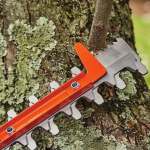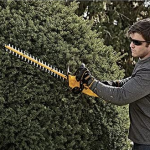A hedge trimmer is an essential tool for maintaining the health and aesthetic appeal of your garden, offering precision and efficiency far beyond manual shears. Whether you’re a homeowner tending to a small yard or a professional landscaper managing large estates, choosing between gas-powered and electric hedge trimmers requires understanding their unique strengths, limitations, and ideal use cases. This detailed comparison helps you make an informed decision based on performance, maintenance, and practicality.
1. Gas Hedge Trimmers: The Powerhouse for Heavy-Duty Tasks
Gas-powered hedge trimmers are engineered for demanding environments, leveraging internal combustion engines to deliver unmatched cutting performance.
Technical Specifications & Performance
- Power Source: 2-stroke or 4-stroke gasoline engines (30–60 cc displacement), producing 1–3 horsepower.
- Cutting Capacity: Effortlessly slices through stems up to 1.5” thick (depending on blade quality and engine power).
- Runtime: Unlimited, limited only by fuel tank capacity (typically 0.5–1 gallon, lasting 1–2 hours per fill).
Key Advantages
- Unmatched Power for Tough Jobs
- Ideal for dense, overgrown hedges (e.g., privet, laurel) or woody shrubs like ligustrum. High-torque engines handle wet or dry growth without stalling.
- Commercial-grade models (e.g., Husqvarna 128LD, Stihl HSA 86) feature anti-vibration systems to reduce user fatigue during extended use.
- True Cordless Freedom
- No reliance on power outlets or battery charging—perfect for large properties, rural areas, or jobsites without electricity.
- Enhanced mobility allows trimming tall hedges (using extension poles) or reaching awkward angles without cable restrictions.
- Durability for Professional Use
- Heavy-duty steel blades and robust engine construction withstand daily use in commercial settings.
- Models like the Echo PAS-2620T offer detachable shafts for versatile hedge and brush cutting.
Drawbacks & Considerations
- Weight & Ergonomics: Typically 8–12 pounds (excluding attachments), which can cause arm strain during 2+ hours of continuous use. Look for models with balanced weight distribution (e.g., Honda HHT35S).
- Noise & Vibration: Operate at 97–103 dBA (OSHA requires hearing protection above 85 dBA). Vibration levels (3–5 m/s²) may necessitate anti-vibration gloves for comfort.
- Maintenance Complexity:
- Requires regular oil changes (4-stroke) or fuel mixing (2-stroke, 50:1 gas-oil ratio).
- Air filter cleaning (every 20 hours), spark plug replacement (annually), and carburetor adjustments to maintain performance.
- Environmental Impact: Emits hydrocarbons and noise, making them less suitable for noise-sensitive neighborhoods or eco-conscious users.
Best Suited For
- Large Properties: Yards over 1 acre or hedges requiring frequent heavy pruning.
- Commercial Landscapers: Daily use on dense, mature hedges where reliability and power are non-negotiable.
- Rough Terrain: Off-grid locations or yards with limited access to electricity.
2. Electric Hedge Trimmers: The Residential Champion
Electric trimmers, available in corded and cordless designs, prioritize ease of use, affordability, and quiet operation, making them a top choice for home gardeners.
Technical Specifications & Performance
- Power Source:
- Corded: 12–15A electric motors (1,500–2,000 RPM), requiring a grounded 3-prong outlet.
- Cordless: 20–40V lithium-ion batteries (e.g., DeWalt 20V, Makita X2 36V), offering 20–60 minutes of runtime (depending on battery capacity and load).
- Cutting Capacity: Efficient for stems up to 1” thick; ideal for green (non-woody) growth.
Key Advantages
- User-Friendly Design
- Lightweight: 5–10 pounds (cordless) or 6–9 pounds (corded), with ergonomic handles (e.g., Black+Decker LHT2436) for effortless maneuverability.
- Instant Start: No pull cords or engine priming—simply plug in (corded) or press a button (cordless).
- Quiet Operation: 90–95 dBA (corded) or 85–90 dBA (cordless), minimizing noise complaints from neighbors.
- Low Maintenance & Eco-Friendly
- Corded: No moving parts beyond the motor and blades—just occasional blade cleaning and lubrication.
- Cordless: Battery-powered models eliminate engine maintenance, though batteries degrade over time (replace every 3–5 years).
- Zero Emissions: Perfect for environmentally conscious users; cordless models like the EGO Power+ HT2400 offer sustainable operation with recyclable batteries.
- Precision for Detailed Work
- Double-edge blades (common in electric models) provide versatile cutting angles, ideal for shaping topiaries or intricate hedge designs.
- Models like the Worx WG251 feature adjustable blade angles (0–90°) for horizontal, vertical, or angled cuts.
Drawbacks & Considerations
- Power Limitations: Struggle with thick, woody stems or overgrown hedges; repeated cutting may cause motor overheating (corded) or battery drain (cordless).
- Mobility Constraints:
- Corded: Limited by extension cord length (max 100 feet recommended to avoid voltage drop); risk of cutting the cord (use a cord minder for safety).
- Cordless: Runtime restrictions require planning—have spare batteries charged for large jobs (e.g., Ryobi 40V offers 2Ah batteries for extended use).
- Weather Sensitivity: Corded trimmers pose electric shock risks in wet conditions (IPX4-rated models resist splashes but not immersion); cordless trimmers may lose power in sub-freezing temperatures.
Best Suited For
- Residential Yards: Small to medium gardens (up to 0.5 acres) with occasional trimming needs.
- DIY Gardeners: Users prioritizing ease of use, low maintenance, and quiet operation for weekend projects.
- Precision Tasks: Shaping ornamental hedges (e.g., boxwood, yew) or working in tight spaces.
3. Key Decision-Making Factors
Use this checklist to evaluate which trimmer aligns with your needs:
(1) Yard Size & Task Intensity
- Under 0.25 Acres: Corded electric (consistent power, low cost) or cordless (portability, no cable hassle).
- 0.25–1 Acre: Cordless (with spare batteries) or gas (for dense hedges); gas is better for mature, woody growth.
- Over 1 Acre or Commercial Use: Gas-powered (unlimited runtime, heavy-duty performance).
(2) Power Source Preferences
- Convenience: Cordless trimmers offer freedom but require battery management; corded models need outlet access but provide uninterrupted power.
- Environmental Impact: Electric trimmers (especially cordless) are eco-friendly; gas trimmers are better for off-grid use.
(3) Budget & Long-Term Costs
| Factor | Gas Trimmers | Electric Trimmers |
|---|---|---|
| Upfront Cost | $200–$600 (professional models: $800+) | $100–$400 (cordless: $200–$500 with batteries) |
| Maintenance Costs | $50–$100/year (fuel, filters, oil) | $20–$50/year (blade sharpening, battery replacement) |
| Operational Costs | $0.50–$1.00/hour (fuel) | $0.10–$0.20/hour (electricity) |
(4) Safety & Comfort
- Vibration & Noise: Electric trimmers (especially cordless) offer smoother operation; gas trimmers require more robust PPE (hearing protection, anti-vibration gloves).
- Safety Features: Look for dual-action triggers (OSHA-compliant), blade guards, and automatic shut-off (standard in most modern models, e.g., Stihl HSE 81).
4. Expert Recommendations by User Type
- Homeowners with Small Yards:
- Best Value: Corded electric (e.g., Sun Joe HT2410) for budget-friendly, reliable performance.
- Premium Choice: Cordless electric (e.g., Milwaukee M18 Fuel) for portability and quiet operation.
- DIY Enthusiasts & Hobby Gardeners:
- Opt for cordless models with adjustable blades (e.g., Greenworks 24V) for versatility in shaping and detail work.
- Professional Landscapers:
- Invest in gas trimmers with commercial warranties (e.g., Echo SRM-2620T) for durability and power to handle daily heavy use.
Final Verdict: Match the Tool to the Task
- Choose Gas If: You need maximum power, unlimited runtime, and the ability to tackle dense, woody hedges on large or remote properties.
- Choose Electric If: You prioritize ease of use, low maintenance, and quiet operation for smaller yards, occasional trimming, or precision work.
Regardless of your choice, always prioritize safety: wear ANSI-rated eye protection, NRR 25+ hearing protection, and cut-resistant gloves. Regularly maintain your trimmer (sharpen blades, inspect cords/batteries) to ensure optimal performance and longevity. With the right tool in hand, you’ll transform your hedges into a showcase of garden excellence—safe, efficient, and beautifully shaped.

